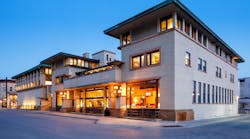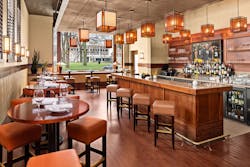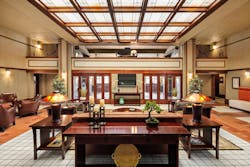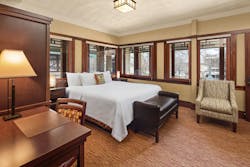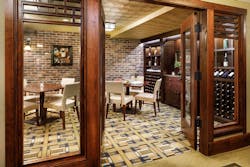Historic Park Inn Hotel Keeps Frank Lloyd Wright's Vision Alive
Assuming management of a property in less than 90 days—let alone less than eight weeks—might have been unheard of for the Historic Park Inn Hotel’s new operators, but it was not unfitting of the Mason City, Iowa site’s storied past.
Indigo Road Hospitality Group assumed management of Frank Lloyd Wright’s last standing hotel at the start of this year, and despite learning they’d gotten the job just before Thanksgiving of 2021, it was a natural grasp for the company that prides itself on their three pillars of experience-driven hospitality: authenticity, discovery and wellbeing. And with a portfolio that includes 28 restaurants, the group had a particular enthusiasm for activating it with fresh F&B options that helped share the hotel’s incredible history—which all started with the two attorneys who commissioned Wright to build it in 1910.
They also created a dedicated website for the property itself with an integrated booking engine and have implemented the use of a digital application called Fetch that allows hotel staff and guests alike to report building maintenance issues.
“That’s the biggest thing we’re doing to contribute to the ongoing upkeep and preservation of this historically important asset,” explained Larry Spelts, head of hotels for The Indigo Road Hospitality Group.
Spelts also credited the owners—a nonprofit group called Wright on the Park—with making proactive upgrades to the hotel’s ventilation system during the winter months. “It’s one of the biggest challenges in preserving and maintaining historic buildings as an operator: they were designed before air conditioning. And once it’s applied to them, if not done properly they can become sick. We’re very pleased with the quality of the engineering for the mechanical systems that are there, because it can be a nightmare to make guests happy if the indoor air quality is not good.”
HVAC upgrades should be completed this fall. Using donations and capital reserve funds for the project, some interior storm windows were also installed to reduce energy costs and more will follow as will the application of a heat-control film on western-facing windows.
A Mission for Restoration
Today, the group offers tours of the hotel and is excited to soon move their offices into the building itself. There are 27 guestrooms, event and meeting spaces, a ladies’ parlor, billiard room and more. But it was not your average project, as Mason City architects Bergland + Cram had to make sure most areas remained true to their original intention.
“We were governed a lot by the state historical society and National Park Service, which oversees historic buildings in the country,” explained Scott Borcherding, principal. “They gave us a lot of specific direction that had to be followed and Wright on the Park didn’t want the facility to feel disjointed. So, a lot of spaces had to be maintained historically but places like the restaurant didn’t. Indigo Road also wanted to keep it cohesive with the rest of the building so you’re not in an ultra-modern restaurant within a boutique, historic hotel.”
Design Details and Direction
Bergland + Cram obtained copies of Wright’s drawings for the project, which of course helped direct them. However, Wright did not oversee construction of the hotel (he was overseas with his mistress at the time), so the team needed to balance what they found on paper with what was actually on site.
Despite their beauty, there were lots of architectural details that stumped both them and Wright fanatics alike as to their purpose. One such riddle was the iridescent glass inserts within the mortar of the brick columns in the bank building, which now serves as an event space. It was absent on any of the plans and difficult to locate in any of Wright’s previous work, not to mention hard to replicate.
Certain pieces had stories of their own, such as the bronze grills over the windows on the bank that ended up about 10 miles to the west as somebody’s fence. The owner donated them back and they were reinstalled along with new ones made to match the originals. Exterior light fixtures were discovered at a Chicago art auction in the ‘90s, but the team had to abandon them as there was no organized effort to save the building yet. The auction house photographed and measured them so they could eventually be recreated.
The composite of all these details gets travelers up and exploring—not just the property itself but also the surrounding community which has greatly benefited from the project. Not only did it keep people employed during the 2008 recession while it was being built up, but it also did wonders for the city’s downtown economic development.
“It’s entirely different now,” explained Marinos. “Part of the money from Vision Iowa included funds for the city streetscape, so they were digging up the streets and putting in new sewer, water and lights. The plaza area next to the hotel was redone with seating, grass and lighting.”
New breweries and restaurants have also popped up since, making the Historic Park Inn Hotel not just a lesson in proper restoration. It proves that determination will always pay off and that there is a reason for everything—even if it’s hidden.
